If you are new to using analog radiation detection instruments, this how-to guide will teach you how to read the meter properly.
Knowing how to read the meter dial is very important for accurate measurements since the meter reading depends not only on where the needle is pointed but also which multiplier or range is selected.
Watch the video form of this article here.

Meter Scale Subdivisions or “Tick Marks”
First, we want to explain how to read the subdivisions, commonly called “tick marks”, on the meter scale. The majority of meter faces have primary and secondary tick marks, while some meter faces also have tertiary (3rd order) tick marks. The following is an example of a meter face with all three types of tick marks.
On the meter face below, the primary tick marks (the largest marks) have a numeric label.

The secondary and tertiary tick marks on this meter face don’t have numeric values printed. The secondary tick marks, which are the medium size marks halfway between the major tick marks, represent a value of 0.5. As an example, the secondary tick mark highlighted in the image below between 1K and 2K would be 1.5K.

There are four tertiary tick marks between the primary and secondary tick marks, meaning each tertiary tick mark on this meter face represents an increment of 0.1. For example, the second tertiary tick mark past the 1K mark, highlighted in the image below, indicates 1.2K.

It is important to remember that the value of the secondary and tertiary tick marks depends on the meter scale. In the example below, there are four secondary tick marks between each primary tick mark on the top CPM scale, meaning each secondary tick mark represents an increment of 0.2. Therefore, on this scale, the second secondary tick mark past 1K indicates 1.4K.
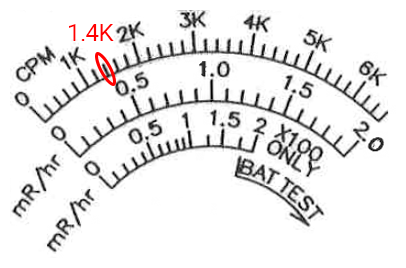
Rotary Switch
Now that we’ve covered the meter scale, let’s move on to the rotary switch. On most meters, such as the Model 3 shown below, the rotary switch positions are called multipliers. This is because you multiply your meter reading by the number selected:
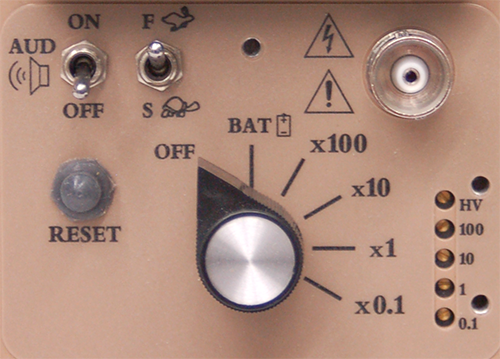
On other meters, such as the Model 19 shown below, the switch positions are called ranges. This is because the number indicates the maximum measuring range of the position:
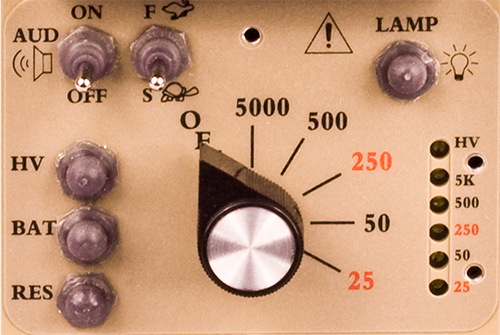
For simplicity, we are we are going to refer to the positions as multipliers. When taking a reading, we suggest starting with the rotary selector switch on the lowest multiplier setting in order to have maximum sensitivity. If the meter goes full scale, turn the selector switch up to the next higher multiplier until a reading is seen.
Examples
We will now show a few examples with the some of the most commonly used Ludlum Model 3 meter faces to demonstrate how to determine the correct reading based on your multiplier setting.
Note: The meter dials shown and multiplier ranges discussed are specific to the Model 3. Your instrument may have different multiplier options, but the basic method described applies to all Ludlum analog meters.
Count Rate Meter Face Example
Count rate meter faces generally can be used with several different detectors since a count is a count no matter which type of detector it comes from. In this example, the count rate scale reads 0 - 5K counts/minute, or 0 - 5 kcpm, where K represents x1000.
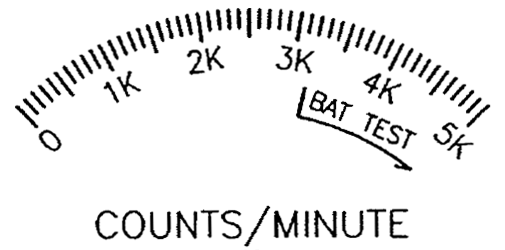
If the needle is pointing as indicated in this image and the rotary selection switch is on the x0.1 multiplier, the reading is 350 cpm (3.5 kcpm multiplied by 0.1 = 350 cpm).
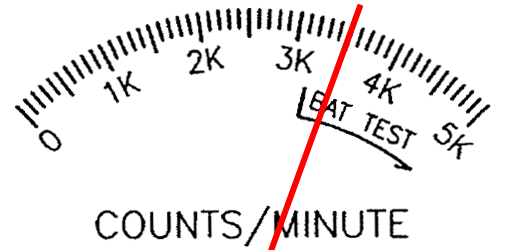
The same needle indication at the other multiplier positions would be:
- 3.5 kcpm (or 3,500 cpm) on the x1 multiplier
- 35 kcpm (or 35,000 cpm) on the x10 multiplier
- 350 kcpm (or 350,000 cpm) on the x100 multiplier
Exposure Rate Meter Face Example
Exposure rate meter faces are each designed to be used with specific detectors. This example is for the Ludlum Model 44-6 and 44-38 GM detectors, and has a dual scale (or two arc) exposure rate meter face. The top scale reads 0 - 2 mR/hr and is valid for the x0.1, x1, and x10 multipliers. The bottom non-linear scale also reads 0 - 2 mR/hr, but is valid only for x100 multiplier. The bottom scale is non-linear because of dead time loss from the detector.
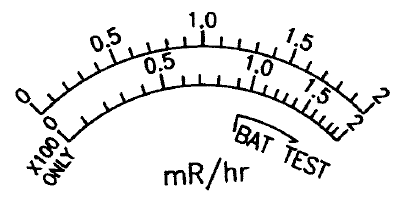
If the needle is pointing as indicated in this image and the rotary selection switch is on the x0.1 multiplier, the reading is 0.1 mR/hr (1 mR/hr multiplied by 0.1 = 0.1 mR/hr).

The same needle indication at the other multiplier positions would be:
- 1.0 mR/hr on the x1 multiplier
- 10 mR/hr on the x10 multiplier
- 70 mR/hr on the x100 multiplier (remember we use the bottom scale for the x100 range)
Combo Meter Face Example
The third meter face example has three arcs: a counts per minute or cpm scale, a linear mR/hr scale, and a non-linear mR/hr scale. This meter face is commonly referred to as a “combo” meter face since it has both count rate (cpm) and exposure rate (mR/hr) arcs.
Similar to the previous example, the middle, linear 0 – 2 mR/hr scale is valid only for the x0.1, x1, and x10 multipliers, and the bottom, non-linear 0 – 2 mR/hr scale is valid only for the x100 multiplier.
Like the exposure rate meter face, a “combo” meter face is specifically designed to be used with a particular detector. In this example, the 1.0 mR/hr mark on the middle arc lines up with 3.3 kcpm on the upper arc. Therefore, this meter face should only be used with a detector that receives 3.3 kcpm per mR/hr, such as the Ludlum Model 44-9 pancake GM detector. (Note that while you can use other detectors that do not have the same cpm per mR/hr sensitivity with this meter face, only the cpm scale is valid for these other detectors. The mR/hr scale is not valid for these other detectors.)
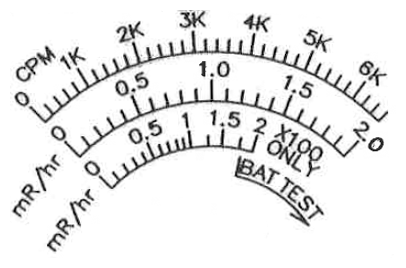
In this image, the needle is on the first tick mark past the 4 kcpm mark. If the rotary selector switch is on the x0.1 multiplier, the reading is 420 cpm (4.2 kcpm multiplied by 0.1 = 420 cpm).
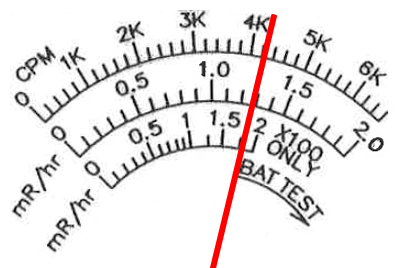
The same needle indication at the other multiplier positions would be:
- 4.2 kcpm (or 4,200 cpm) on the x1 multiplier
- 42 kcpm (or 42,000 cpm) on the x10 multiplier
- 420 kcpm (or 420,000 cpm) on the x100 multiplier
If you use the mR/hr scales, then the readings would be:
- 0.13 mR/hr on the x0.1 multiplier
- 1.3 mR/hr on the x1 multiplier
- 13 mR/hr on the x10 multiplier
- 180 mR/hr on the x100 multiplier (again, remember we use the bottom scale for the x100 range)
Range Selector Example
This section will cover how to take a reading if you are using an instrument with range positions on the rotary switch, such as the Model 19.
In this example, there are two sets of scale numbers: 0 - 50 microR/hr (µR/hr) in black along the top of the arc, and 0 - 25 microR/hr (µR/hr) in red along the bottom. As seen below, the switch positions are also colored black and red, indicating which colored arc you should be reading.


If the needle is pointing as indicated in this image and the rotary selection switch is on the black 5000 position, meaning the maximum scale value is 5000 µR/hr, then the reading is 2000 µR/hr (black arc).
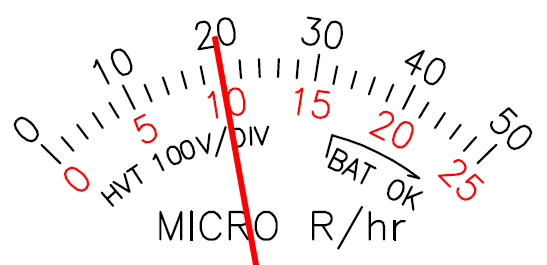
The same needle indication at the other range positions would be:
- 200 µR/hr on the 500 range (black arc)
- 100 µR/hr on the 250 range (red arc)
- 20 µR/hr on the 50 range (black arc)
- 10 µR/hr on the 25 range (red arc)
This covers the main types of meter faces you will see on Ludlum analog meters. Hopefully you now understand how to properly take a reading based on the meter needle position and the selected multiplier or range of your Ludlum analog meter. If you have further questions about this topic, please contact your local sales representative or contact us at Ludlum Measurements directly.
